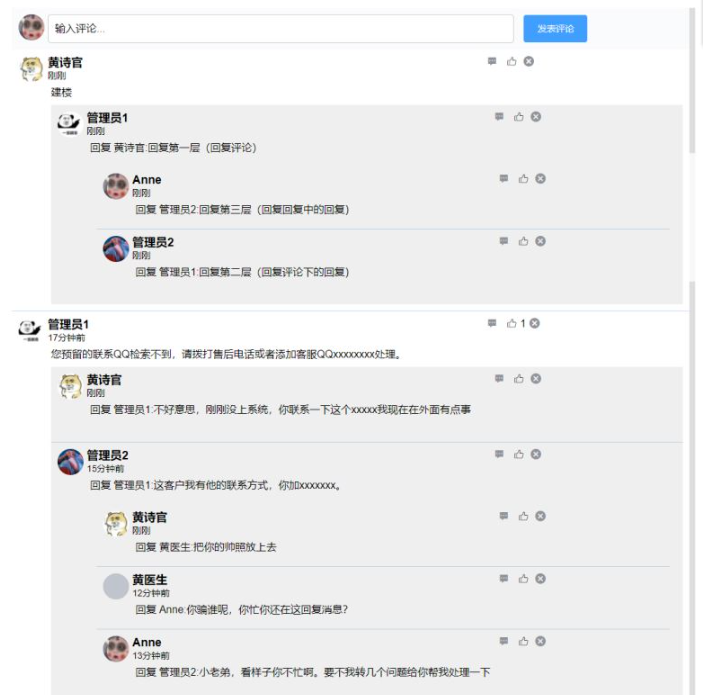
답글에는 총 2단계가 있습니다(댓글에 대한 답변, 댓글 아래의 답변에 대한 답변)
댓글 테이블(TFW_Comments)과 댓글 내용 테이블(TFW_UserResponse) 및 댓글 답변 관계 테이블 (TFW_MsgRelation)
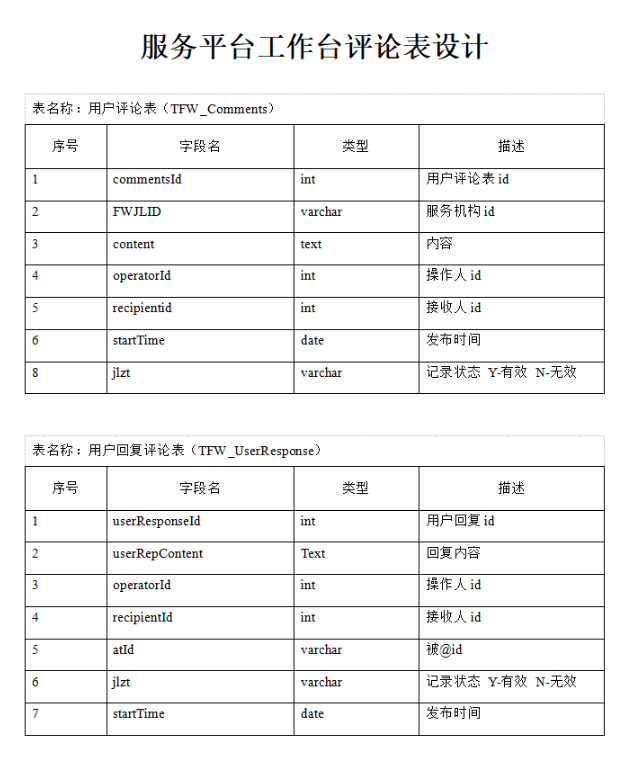
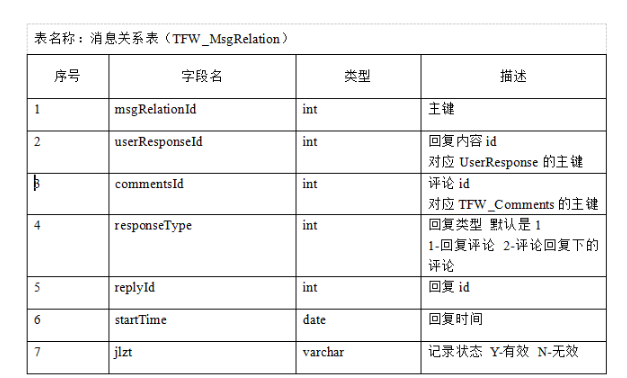
참고: 독자는 댓글 테이블의 서비스 조직 ID 필드를 자동으로 무시합니다. 이 필드는 이 댓글이 있는 게시물(기사 아래)
과 동일합니다. 1. 기사 ID에 따라 또는 댓글을 얻기 위해 댓글 테이블을 조회하는 게시물 ID(이 기사의 서비스 기관 ID)입니다. 첫 번째 수준(댓글)
두 번째 수준 응답(commentsId)을 얻으려면 댓글 ID를 기반으로 관계 테이블에서 쿼리해야 하며 응답 유형은 1입니다. 두 번째 레이어(댓글 아래 답글)
댓글 ID, 답글 유형 2, 답글 ID를 기반으로 관계 테이블에서 세 번째 레이어 답글 정보를 얻습니다. 세 번째 수준(댓글 아래 답변의 답변) 참고: 답변 ID는 상위
@Override
public Map<String, Object> findComments(JSONObject jsonObject) {
data.clear();
String userId = jsonObject.getString("userId");
String role = this.role(jsonObject);
if (role.equals("-1")){
//没有权限
data.put("error","-1");
data.put("msg","当前用户没有权限");
return data;
}
List<Map<String, Object>> info = commentsDao.findComment(jsonObject.getString("fWJLID"),null);
//查询点赞次数
int countTag = 0;
MsgRelationTag msgRelationTag = new MsgRelationTag();
for (Map item : info){
item.put("inputShow",false);
int commentsId = (int) item.get("commentsId");
//查询点赞次数
countTag = msgRelationDao.findCountTagByTagId(commentsId,1);
item.put("countTag",countTag);
//设置点赞状态
msgRelationTag.setTagId(commentsId);
msgRelationTag.setTagType(1);
msgRelationTag.setTagUserId(Integer.parseInt(userId));
MsgRelationTag msgTag = msgRelationDao.findMsgTag(msgRelationTag);
if (msgTag != null) {
item.put("tagStatus",msgTag.getStatus());
}else {
item.put("tagStatus","");
}
//如果有@id
if (item.get("atId") != null){
String content = item.get("content").toString();
StringBuffer tmrAtId = findUserName(item.get("atId").toString());
item.put("content",content+'@'+tmrAtId);
}
//二级回复数据
List<Map<String, Object>> twoReply = new ArrayList<>();
//所有数据
List<Map<String, Object>> userResponse = userResponseDao.findUserResponse(commentsId, null, "","",null);
for (Map userResponseInfo :userResponse){
int userResponseIds = Integer.parseInt(userResponseInfo.get("userResponseId").toString());
//查询点赞次数
countTag = msgRelationDao.findCountTagByTagId(userResponseIds,2);
//设置点赞状态
msgRelationTag.setTagId(userResponseIds);
msgRelationTag.setTagType(2);
msgTag = msgRelationDao.findMsgTag(msgRelationTag);
if (msgTag != null) {userResponseInfo.put("tagStatus",msgTag.getStatus());}else {userResponseInfo.put("tagStatus","");}
userResponseInfo.put("countTag",countTag);
userResponseInfo.put("inputShow",false);
Integer responseType = (Integer) userResponseInfo.get("responseType");
for (Map stairReplyInfo : userResponse){
Integer userResponseId = (Integer) stairReplyInfo.get("userResponseId");
int msgRelationId = Integer.parseInt(stairReplyInfo.get("msgRelationId").toString());
//接受者id*/
twoReply = userResponseDao.findUserResponse(msgRelationId, userResponseId,"1","",null); //二级回复数据
for (Map twoReplyItem : twoReply){
int twoReplyId = Integer.parseInt(twoReplyItem.get("userResponseId").toString());
twoReplyItem.put("inputShow",false);
//查询点赞次数
countTag = msgRelationDao.findCountTagByTagId(twoReplyId,2);
twoReplyItem.put("countTag",countTag);
//设置点赞状态
msgRelationTag.setTagId(twoReplyId);
msgTag = msgRelationDao.findMsgTag(msgRelationTag);
if (msgTag != null) {twoReplyItem.put("tagStatus",msgTag.getStatus());}else {twoReplyItem.put("tagStatus","");}
String userRepContent = twoReplyItem.get("userRepContent").toString();
if (twoReplyItem.get("tmrAtId") != null){
StringBuffer tmrAtId = findUserName(twoReplyItem.get("tmrAtId").toString());
twoReplyItem.put("userRepContent",userRepContent+'@'+tmrAtId);
}
}
stairReplyInfo.put("twoReply",twoReply);
}
}
item.put("stairReply",userResponse);
}
data.put("data",info);
data.put("error",0);
data.put("msg","查询成功");
return data;
}다른 코드는 무시할 수 있습니다. 주요 문장은 다음과 같습니다.
List<Map<String, Object>> info = commentsDao.findComment(jsonObject.getString("fWJLID"),null);위 사진은 FWJLID를 기준으로 댓글을 가져왔습니다. (이것은 게시물의 ID로 사용되어 게시물 아래의 댓글을 가져올 수 있습니다.) 레벨 1 표시
는 SQL 문에 해당합니다(OPT는 내 사용자 테이블입니다)
select tc.content ,tc.commentsId,convert(varchar(19),tc.startTime,120) as startTime,tc.recipientId ,tc.operatorId,zo.NAME as operatorName,tc.atId,zo.HeadImgUrl as operatorHeadImgUrl
from TFW_Comments tc
left join zd_opt zo on zo.AID = tc.operatorId where tc.FWJLID = 5101쿼리 결과:

List<Map<String, Object>> userResponse = userResponseDao.findUserResponse(commentsId, null, "","",null);
위 사진은 commentsid를 기준으로 댓글 아래의 답글을 가져옵니다. (댓글 ID를 기준으로 응답 가져오기) 2차 디스플레이
는 sql 문
select
tur.userResponseId,tur.operatorId,tur.recipientId,convert(varchar(19),tur.startTime,120) as startTime,tur.userRepContent,tmr.atId as tmrAtId,
tmr.msgRelationId ,tmr.responseType,tmr.replyId,
zo.NAME as operatorName,
zo1.NAME as recipientName,
zo.HeadImgUrl as operatorHeadImgUrl,
zo1.HeadImgUrl as recipientHeadImgUrl
from TFW_MsgRelation tmr
left join TFW_UserResponse tur on tur.userResponseId = tmr.userResponseId
left join zd_opt zo on zo.AID = tur.operatorId
left join zd_opt zo1 on zo1.AID = tur.recipientId where tmr.commentsId = 47에 해당합니다. 쿼리 결과

twoReply = userResponseDao.findUserResponse(msgRelationId, userResponseId,"1","",null); //二级回复数据
위 그림은 2차 응답을 가져오는 것입니다. -댓글 ID(msgRelationId) 및 답글 ID(userResponseId) 수준 응답을 기반으로 하는 수준의 응답입니다. 응답 ID도 상위 클래스입니다. 답변의 ID입니다. 세 번째 레이어 표시
는 sql
select
tur.userResponseId,tur.operatorId,tur.recipientId,convert(varchar(19),tur.startTime,120) as startTime,tur.userRepContent,tmr.atId as tmrAtId,
tmr.msgRelationId ,tmr.responseType,tmr.replyId,
zo.NAME as operatorName,
zo1.NAME as recipientName,
zo.HeadImgUrl as operatorHeadImgUrl,
zo1.HeadImgUrl as recipientHeadImgUrl
from TFW_MsgRelation tmr
left join TFW_UserResponse tur on tur.userResponseId = tmr.userResponseId
left join zd_opt zo on zo.AID = tur.operatorId
left join zd_opt zo1 on zo1.AID = tur.recipientId where tmr.commentsId = 136 and tmr.replyId = 155쿼리 결과

반환 페이지 표시 및 반환 본문 표시
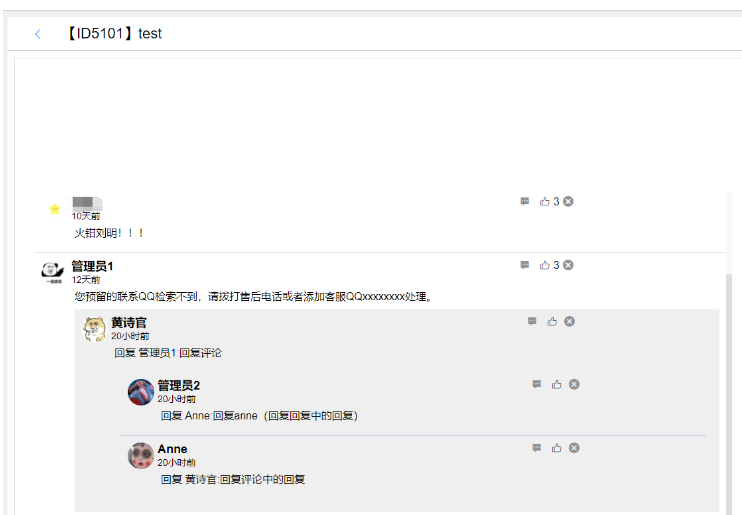
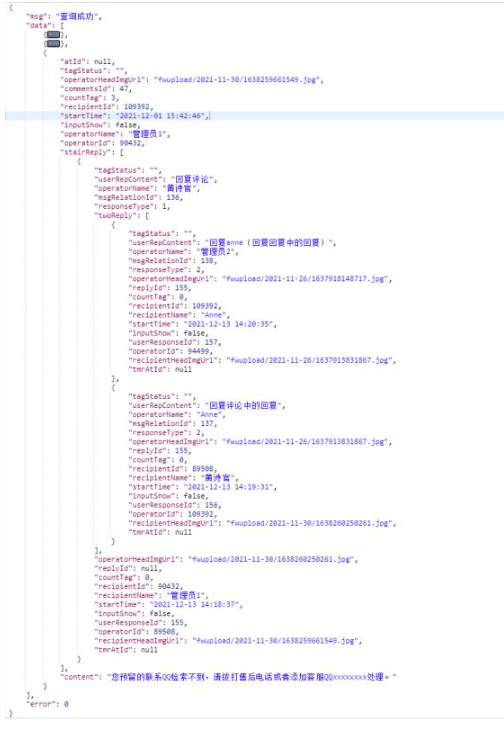
위 내용은 Java에서 댓글 및 응답 기능을 구현하는 방법의 상세 내용입니다. 자세한 내용은 PHP 중국어 웹사이트의 기타 관련 기사를 참조하세요!